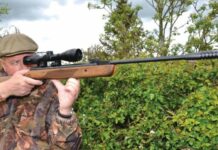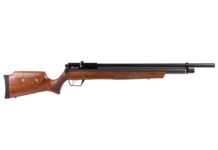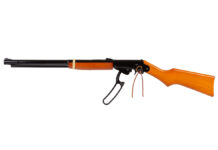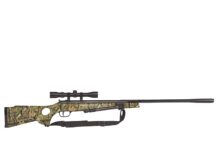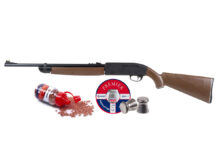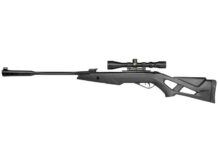In our previous post, we talked about the intricacies of deer vision, focusing on their perception of color, sensitivity to light, ability to detect movement, and their response to blue-spectrum and UV light. With that foundation, it’s time to delve into choosing the best camo for deer hunting in different hunting environments and seasons.
In this follow-up post, we’ll discuss what the science says about deer vision and camouflage and how to use them to enhance your concealment and help you choose the right camouflage for hunting deer.
Table of Contents
- Selecting the Right Camouflage to Beat Deer Vision
- Why Mimicry Camo Might Not Be the Best Camo
- The Effectiveness of Computer-Generated “Disruption” Camo Patterns
- Mastering the Art of Concealment
- The Best Camo for Deer Hunting
- The Best Camo Patterns for Bow Hunters in Treestands
- What Deer Science Says
- Conclusion
Selecting the Right Camouflage to Beat Deer Vision
Choosing the right camouflage can make all the difference in a successful deer hunt. Deer have exceptional vision, and hunters need to be aware of how they perceive colors and movement to avoid detection. In this section, we’ll look at the science behind deer vision and how it relates to camouflage.
- Match your environment: Choose a camouflage pattern that blends well with the dominant colors, patterns, and textures of your hunting environment.
- Adapt to the season: Select camouflage that reflects the changing foliage and vegetation throughout the hunting season. Early-season hunts may require more green elements, while late-season hunts call for patterns with more browns and grays. Snowy environments or winter hunts may necessitate snow camouflage patterns.
- Consider deer’s unique color perception: Deer perceive reds, oranges, and some tans and grays as shades of green or gray. Be cautious when selecting camouflage patterns, as they may appear effective to human eyes but stand out to deer due to their unique color perception.
- Minimize blue-spectrum and UV visibility: Since deer are sensitive to blue-spectrum and UV light, avoid clothing and gear treated with brighteners, which can make them more visible to deer. Use UV-free detergents for washing your hunting gear and consider using UV-blocking sprays on your clothing and equipment to minimize the chances of being detected by deer.
READ: Deer Vision 101: How Deer See Color, Light, and Movement

Why Mimicry Camo Might Not Be the Best Camo
Mimicry camo, which uses pictures or photos of sticks, leaves, bark, trees, etc. to mimic the environment, is the most common type of hunting camouflage. These patterns can look incredibly realistic to the human eye and provide a sense of satisfaction to the hunter wearing them.
As research into deer vision and behavior has advanced, it has become clear that mimicry camo may not be the most effective option for hunting. While these patterns may look highly detailed to the human eye, deer perceive them as blurry blobs of color. Instead, patterns that use disruptive shapes and colors to break up the hunter’s outline have been shown to be more effective at fooling the eyes of whitetail deer.
While mimicry camo may look great to human eyes, it may not always be the most effective choice when hunting deer. By understanding the limitations of deer vision and the importance of breaking up your outline, you can make an informed decision when choosing your hunting apparel and give yourself the best possible chance of success.
The Effectiveness of Computer-Generated “Disruption” Camo Patterns
In recent years, computer-generated “disruption-style” camo patterns have become increasingly popular among hunters. With advancements in technology, it’s easier than ever to create intricate designs and patterns that are meant to mimic natural surroundings. But are these patterns actually effective? In this section, we’ll take a closer look at the effectiveness of computer-generated camo patterns and compare them to traditional, nature-based mimicry patterns.
Disruption camo is designed to break up the outline of the hunter and create the illusion of depth using different-sized patterns. This method tricks the animal’s eyes into not recognizing the subject as one single object, which makes it harder for them to identify the threat. In essence, disruption camo is designed to trick the animal’s eyes into not seeing anything at all.

- Kuiu, Sitka, Huntworth, and Forloh: These companies have developed advanced camouflage patterns using computer algorithms and digital technologies to create intricate designs that blend effectively with different types of terrains and vegetation. Their patterns can be quite effective for bow hunters, as they help to break up the human silhouette and blend seamlessly with the environment.
- Asio Gear’s owl-inspired camo: Asio Gear has developed a camouflage pattern specifically for bow hunters, inspired by the natural plumage of owls. This unique pattern is designed to mimic the disruptive coloration and patterning found in owl feathers, which help owls remain concealed from their prey. The effectiveness of this pattern for deer hunting will depend on the specific environment in which you are hunting and how well the colors and patterns match the local vegetation and terrain.
Modern hunting gear companies like the ones detailed above have developed innovative, computer-generated camouflage patterns designed to provide better concealment in various hunting environments. These patterns are often based on detailed studies of natural environments and animal vision, with the aim of increasing their effectiveness in fooling the keen eyes of deer and other game animals.

READ: Bow Hunting Clothes: Optimizing Camo, Scent, and Stealth
Mastering the Art of Concealment
Effective camouflage is just one piece of the puzzle when it comes to successful bow hunting. In addition to choosing the right gear, it’s important to master the art of concealment. This means staying motionless, scent-free, and taking advantage of natural cover to blend into the environment. In this section, we’ll explore the key strategies and techniques for concealing yourself effectively while bow hunting.
- Blend with the environment: Choose a camouflage that closely resembles the natural patterns and contrasts in your hunting area, helping you to blend in seamlessly.
- Minimize movement: Deer are highly sensitive to movement, so remain as still and quiet as possible when waiting for the perfect shot.
- Maintain awareness: Stay vigilant and keep an eye on your surroundings. Deer have a wide field of view, and their heightened senses can detect even the slightest disturbances.
- Camouflage vs. solid colors: While it’s possible to hunt deer without wearing camouflage, using camo can improve your chances of remaining concealed and undetected. For bow hunters, who need to get closer to their quarry, being able to break up your outline and blend into your environment is critical to your success. However, it’s crucial to combine camo with other hunting strategies and choose the appropriate pattern for your hunting environment and season.
It’s also important to consider other gear that can reduce visibility, such as face masks, gloves, and boots. These items should also match the camo pattern of the clothing.

The Best Camo for Deer Hunting
When it comes to deer hunting, camouflage isn’t just a fashion statement – it’s a crucial tool for success. Understanding deer vision and visual processes is key to creating effective camouflage that works in two ways. First, it must break up the hunter’s 3-dimensional shape and avoid stimulating the ambient system. This is achieved through an effective macro pattern.
Second, if the hunter is detected, the camouflage must prevent or delay recognition by making the hunter appear to have a completely different texture, which is where the micro pattern comes into play. Camouflage gives hunters an extra edge in the difficult pursuit of hunting by enhancing their concealment and increasing their chances of a successful hunt.
Many hunting clothing companies offer camouflage patterns that incorporate both macro and micro patterns to effectively break up the hunter’s shape and texture.
Some examples of such camo patterns include:
- Sitka Optifade Subalpine and Elevated II (and all the other variations they have)
- Kuiu Valo, Verde, and Vias
- First Lite Specter
- Huntworth Disruption
- True Timber Strata
- Under Armour Ridge Reaper Barren
These patterns use a combination of larger and smaller shapes, colors, and textures to create a highly effective camouflage that can help hunters remain hidden from deer.
There isn’t a single combination of colors that works optimally to beat deer vision, but generally speaking, camo patterns that incorporate shades of brown, green, and gray are the most effective. These colors match the natural environment, work against what a deer can see best, and reduce the silhouette of the hunter, making them less detectable.
It’s also important to choose a camo pattern that matches the specific environment and season you’ll be hunting in, as this can vary greatly depending on the location and time of year. Ultimately, the best combination of colors will depend on the individual hunting situation and environment you are in.
*Does mimicry camo work for deer hunting? Of course, it does. Deer have limited ability to see fine details, making mimicry camo effective, especially in environments where the camo closely matches the surroundings. However, based on my experience, I choose disruption-style camo 90% of the time. Disruption-style camo is designed to break up the human outline and create visual confusion, providing reliable concealment in various environments. While mimicry camo excels in perfectly matched environments, disruption-style camo offers versatility and effectiveness even when the colors and patterns may not perfectly align. This is why disruption-style camo has become my preferred choice for its all-around performance.
The Best Camo Patterns for Bow Hunters in Treestands
For bow hunters who hunt from treestands or elevated positions, there are disruption-style camo patterns specifically designed to blend into the vertical lines of trees. Sitka’s Elevated II and Kuiu’s Vias Camo are examples of camo patterns that utilize a mix of grays and greens to break up the human silhouette against the vertical lines of trees.
When hunting from a treestand, it’s important to consider the angle at which deer are likely to approach. Camouflage that blends in well with the vertical lines of trees can be particularly effective when deer are approaching from below, as it helps to break up the hunter’s outline and prevent them from being spotted.
Some of the best camos for deer hunting from a tree stand are:
- Sitka’s Elevated II
- Kuiu’s Verde (Early season)
- Kuiu Valo (Mid-season)
- Asio Gear’s Raptor Camo (See my mid-season gear review here)
- True Timber Strata
- Huntworth Disruption (or Tarnen)
What Deer Science Says
Understanding the science behind deer vision and camouflage is crucial for any serious bow hunter. As hunters, we want to reduce our visibility to deer and increase our chances of a successful hunt. Thanks to a number of scientific studies, we now have a better understanding of what camo patterns work best and why.
There are a number of scientific studies that support the effectiveness (or lack of) of camo patterns that mimic the environment. For example, a study conducted by the University of Georgia found that hunters wearing naturalistic camouflage patterns (mimicry) were less visible to deer than those wearing non-naturalistic patterns or solid colors.
Here are some additional resources and studies that can provide more scientific insight into deer vision and how it relates to the camouflage you wear when hunting:
- New York Times
- The Free Library
- The Deer Laboratory
- North Country Whitetails
- The Outdoor Channel
- Desolve Camouflage Camo Science
Conclusion
By applying your understanding of deer vision to your choice of camouflage, you’ll be better prepared to blend into your hunting environment and stay concealed from the keen eyes of whitetail deer. Remember to select a pattern that closely matches the natural colors, patterns, and textures of your hunting area, and adapt your camouflage according to the season.
Additionally, bear in mind that deer rely on other senses, such as hearing and smell. Thus, it’s essential to minimize noise, control your scent, and remain aware of wind direction while hunting. By combining all these elements, you’ll become a more proficient and effective whitetail deer bow hunter.
Understanding how deer see and process information is essential when trying to find the best camo for deer hunting. While many camouflage patterns use mimicry to blend in with natural environments, ungulates (deer) do not perceive fine detail the same way humans do. Instead, breaking up your outline is the key to effective camouflage, using different-sized patterns to create the illusion of depth and disrupt the animal’s ability to recognize one single object. This is where disruptive camouflage patterns can be more effective than mimicry patterns. By focusing on our outline, removing contrast to the environment we are hunting in, and using effective camouflage, we can reduce our visibility and increase our chances of a successful hunt.
While I didn’t list every deer hunting camouflage that meets the criteria in this post, you can now take this information and make an informed decision on what to buy the next time you are shopping for bow hunting clothes.




